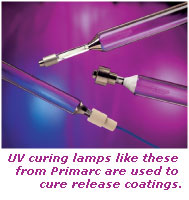Release Liner Special Report, Part 3
- Published: November 01, 2007, By By Thomas Hohenwarter, THresource LLC
Part 1 | Part 2 | Part 3
Curable Coatings
The use of silicone acrylates and silicone epoxies in the production of release coatings is no longer a new technology. It has become firmly established in the pressure-sensitive tape and label market, even in the production of prime labels. However, most of the growth continues to be in niche areas such as specialty labels and integrated business forms. Growth is healthy and is projected to remain so due to this specialty business.
The most recent changes in the industry have had to do with corporate restructuring. Among the major North American players are GE Silicone, whose products became part of Momentum; Rhodia products, which now belong to Bluestar; and Degussa, now part of Evonik Industries.
The focus has become more internal in nature: trying to control costs while being squeezed from both ends (higher raw material cost and demand for lower-cost products from the converter). A key element has been refinement of production processes to make them more efficient.

Adding Value
Research is based on finding new oligomers that are more efficient to produce, yet still provide the quality demanded by the industry. Finding better, more efficient photo initiators/catalysts is also a key research area.
Silicone suppliers have been successful in working with co-suppliers to make the technology more turnkey and operator friendly. Equipment now is available with processes for system-integrated coating and curing (including the inerting necessary for use of the acrylate system). Substrate suppliers (paper and film) have paid attention and now offer grades better suited for the radiation-curable chemistries.
One of the attractions of the radiation-curable chemistries (especially the acrylate systems) is the ability to add value in the final formulations. Release coatings now are asked to do more than just protect and release the p-s adhesive. New self-wound products require the release coating to become a functional part of the final product. They can be modified with materials to adjust gloss, color, and hardness of the final coating.
This has come about because converters are looking to add value to their products. Radiation-curable silicones make this easier, allowing the use of thinner or less heat-resistant substrates, etc., which makes linerless applications easier to achieve. There are still areas of opportunity here—for instance, a release coating that can be written on for integration into shipping documents, or for self-wound stamps. Integration of the equipment necessary for radiation curing has allowed the technology to be used in the narrow web industry, giving the label converter more control over product design and quality.
North America and Europe continue to see good growth in the specialty sector, but the availability of turnkey equipment has helped to open new geographic market areas, Asia and South America in particular. Here, investment is easier because “old technology” currently is not in use.
Too Costly?
A key impediment to growth in radiation curing has been the impression that it “costs more.” This usually is based on the simple fact that the silicone cost is higher on a solid-per-pound basis. It is a goal of the industry to educate the user to look at the entire technology cost—material, equipment, waste, etc. In particular, the rising cost of energy makes the use of radiation curing even more attractive.
The radiation-curable silicones industry is viable and active. New and improved products continuously are introduced as market requirements change. Co-suppliers and equipment manufacturers have assisted in making this a successful venture.
Thomas Hohenwarter, owner of THresource LLC, Chester, VA, is a consultant to the tape and label industry with more than 20 years’ experience in p-s adhesives and release coatings. His specialty is radiation-curable silicone. Contact him at 804-767-0127; This email address is being protected from spambots. You need JavaScript enabled to view it..
Part 1 | Part 2 | Part 3




